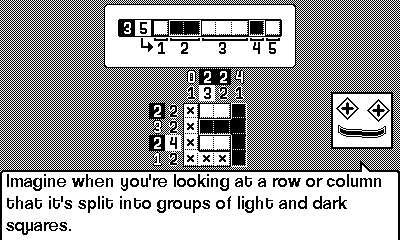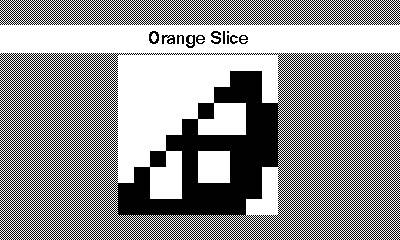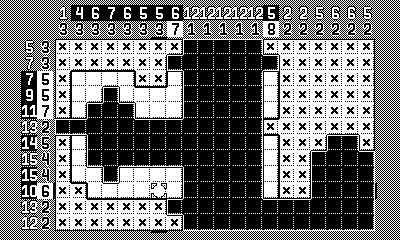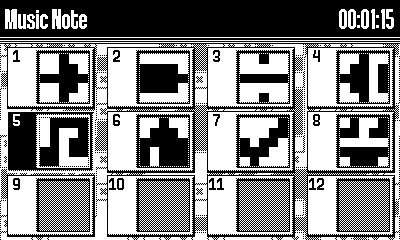Juxtagram

Are you looking for a picross/nonogram-type of puzzle that is legally distinct from picross/nonogram puzzles? Then I have a game for you!
At first glance, Juxtagram looks like any other picross-style puzzle—the type that has the grid with the numbers at the top and side that tell you how many squares to fill in and in what order, with the end goal being to reveal an image. However, Juxtagram puts a key twist on this formula. In picross, a row with the numbers 2, 1, 3 means that it contains (from left to right) two filled squares next to each other, one filled square alone, and three filled squares all next to each other. The trick is figuring out where exactly in the row these fills go, but you will always know their size and position in relation to one another.

Juxtagram gives you exactly two numbers per row and column. The first tells you how many total squares are filled in, whereas the second tells you how many "groups" of filled and non-filled squares there are (or, to visualize it more easily, how many groups of white and black). Let's see some examples:
- If a row shows 5, 2, this is pretty simple; there are only two groups, so by default one must be white and one black. The 5 filled squares are all aligned against one side of the grid (because otherwise there would be more than 2 groups); it's just a matter of determining which side.
- A row showing 5, 3 is a little trickier. Now, we could be looking at any combination of 5 squares being filled on either end of the row (leaving 2 black groups and 1 white), or we could have five black squares all filled in together somewhere in the center of the row, with white at the ends (2 white groups and 1 black).

And so on. It's a clever take on the standard conventions, and the little tricks that you've already learned to help solve picross puzzles won't help you here; instead, there's an all-new set of tricks to learn. But as always, it all boils down to "determine what has to be true, and use that to determine what else has to be true".
I did finish every puzzle offered in this game, and it took me, you know, months. Of course, some of the early ones can be knocked out in mere minutes, but as the grids get larger, the length of time spent on a single puzzle really started to balloon, some taking me over an hour to complete. Coincidentally, I think one of the potential problems with this format is that, once a row/column starts to contain around 6 or more groups, it just becomes really hard to do anything with. Remember, figuring out the size of each group is one of the challenges you have to overcome; but when you have so many groups, it just seems like there are too many possible combinations to make any sort of guess, and you need to rely on the crosses to help find your footing. Of course, if those crosses also contain a lot of groups...

This is where I would get stuck most often, spending quite a long time squinting at my half-filled rows and columns, wracking my brain and trying to find even one square to confidently mark in an attempt to make any sort of progress. Of course, even if I was eventually able to do so, it was often not enough to start any sort of chain reaction, and I would go back to searching. Although the entirety of my previous picross experience was Murder By Numbers—my memory of which being a little on the hazy side since it was a few years at this point—I never remember feeling so stuck playing that game, or at least never so often. Maybe there was still some Juxtagram tactic I hadn't gleaned through gameplay yet... I can't say. Fortunately, I didn't have this problem until after I'd completed well over half the available puzzles, so there's still plenty available if you're more interested in a casual solve.
My crutch through the hardest of these puzzles ended up being the game's snapshot system, which is hidden in the pause menu of a game that doesn't need paused, and which the game never highlights, so I didn't even know it existed until I was two-thirds the way finished. You have the option to save a puzzle's state and load it later, although by far the most useful option is the auto-snapshot, which will revert your board back to the last time you didn't have any squares incorrectly marked. This made it quite easy to do a guess-and-check so I could get moving again during the times I got stuck. Which... is a bit cheating, yeah. But I'm also at the age where I can't justify spending an entire evening beating my head against a wall trying to make progress on a single puzzle. I got other games to play.

Also, the maximum puzzle size is somewhat hampered by the small resolution of the Playdate, with the biggest puzzles coming in at 20x12. It takes the game a while to ramp up to these larger sizes, so you'll spend a fair amount of time on smaller, less-detailed images (although the game doesn't lock its categories behind mandatory completion, so if you want to jump to the end right away you're more than free to do so.)
No crank action in this one, although in a game of this nature that hardly comes as a surprise. If you figure out how to add a decent cranking mechanic to a picross game, please let me know and I'll play it.

- Gameplay: Medium
- Presentation: Medium
- Crankitude: Nil
Verdict: There's only maybe 4 songs that play while you solve, but boy some of those go way harder than they need to and I'm over here bopping.